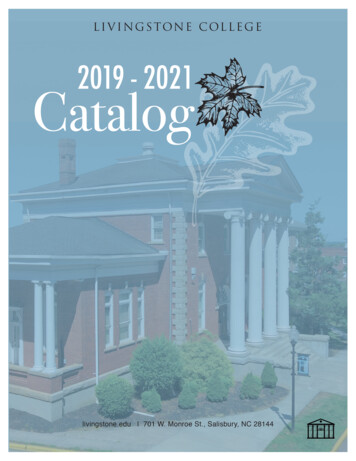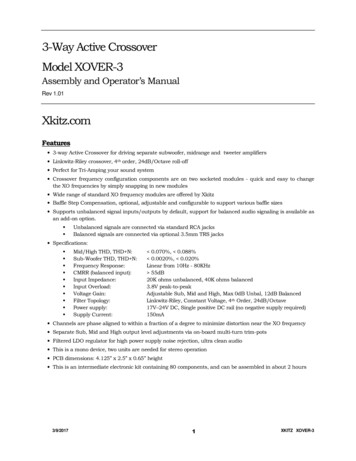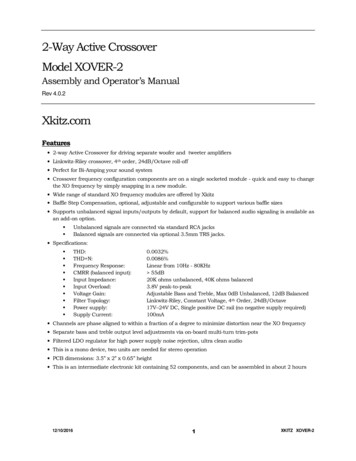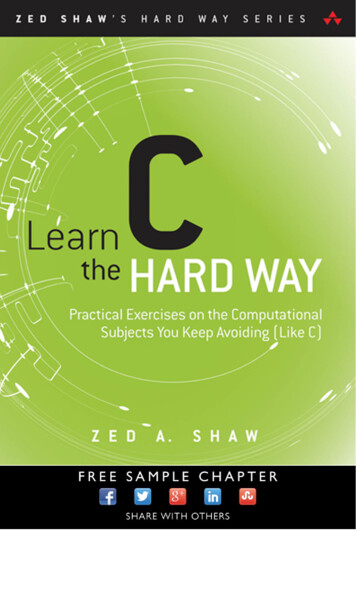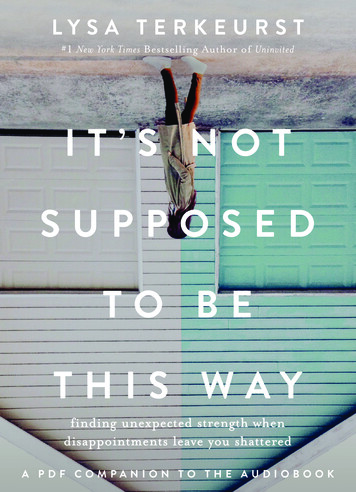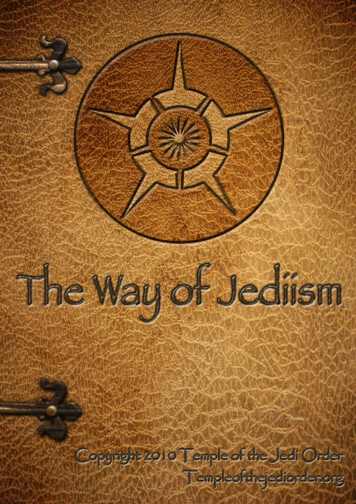
Transcription
The Way of Jediism-1-Temple of the Jedi Order (templeofthejediorder.org)
The Way of JediismFirst EditionPublished by the Templeof the Jedi Order (TOTJO)First International Church of Jediism (charter received Dec 25th 2005)www.TempleOfTheJediOrder.orgAll content is copyrighted to the Temple of the Jedi Order and the relevant authors, July 2010.Edited by John Henry Phelan (Patriarch/President/Senior Pastor) , Mark Barwell (Cardinal Bishop/VP/Associate Pastor) andHans Thomas Finch. Front cover courtesy of Alejandro Mascaro (Knight of Jediism at the Temple of the Jedi Order)The Way of Jediism-2-Temple of the Jedi Order (templeofthejediorder.org)
Table of ContentsJediism – a 21st Century Paradigm.3Jedi Doctrine as defined by the Temple of the Jedi Order.6Becoming a Jedi.816 Basic Teachings of the Jedi.8The Jedi Creed.10The Orthodox Jedi Code.113 Primary Tenets of Jediism.11Jedi Oaths.12The 12 Vows of the Jedi.12Ranks within the Temple of the Jedi Order.14Clerical Structure of the Temple of the Jedi Order.15Special Interest Groups.17Liturgical Calendar.18Study and Qualifications.23Personal Stories.24Selected Sermons.27Knighting Ceremony.39Ordination Ceremony: Deacon/Priest.42Ordination Ceremony: Bishop.46Marriage Ceremony.50Funeral / Memorial Service (version 1).52Funeral / Memorial Service (version 2).54Ceremony for Consecration of Land.57Ceremony for Consecration of Temple/Church.58Selected Prayers.62The Way of Jediism-3-Temple of the Jedi Order (templeofthejediorder.org)
Jediism – a 21st Century ParadigmSo what is Jediism? Perhaps it's better to begin by saying what Jediism is not. It's not a roleplaying opportunity, it's not a joke, and it's not a delusional fantasy for those whose dream is towield a lightsaber and talk like Alec Guinness. Jediism is an inter-faith initiative and syncretisticreligion - meaning that it involves elements from more than one religious practice – that wasinspired by the ideals and tenets of the fictional Jedi as portrayed in the Star Wars films, includingconcepts such as peace-keeping, humility, courage, wisdom and faith.Delving deeper into the story of Star Wars, we see that George Lucas (writer, producer and sometime director of the Saga) based the central plot and characterisations on archetypal myths andfigures that can be found in different forms throughout human history and he was very muchinfluenced by the thoughts and writings of his friend Joseph Campbell, mythologist andcomparative theologist. It's no coincidence that upon the release of Star Wars in 1977, many worldreligions claimed that the story mirrored the legends and parables of their own beliefs.Shanti Feder, editor of Parabola Magazine (published by the Society for the Study of Myth andTradition) wrote: “In classic mythology, the hero reluctantly leaves the homeland (in Luke[Skywalker]'s case, the planet Tatooine) on a quest that takes him over a supernatural thresholdinto a strange land. A helper/co-hero such as space jockey Han Solo lends a steady hand througha series of ordeals. Comic relief is provided by tricksters such as the Greek muse Thalia or C3POand R2-D2. Ultimately, the hero must stand on his own, face the darkness and conquer it beforereturning to reality, stronger and wiser. “One of the reasons for Jediism being treated as little more than a joke concerns the fact that it isinfluenced by the concepts behind a (reasonably recent) film series. Feder continues:“There is the test-of-time thing to consider. A lot of people would hesitate to put the label of ‘myth’on something relatively new like Star Wars. But, a myth is a myth, no matter what trappings we puton it. Give them light sabers instead of swords and it doesn't matter.”After all, the structure and practices of Wicca are fairly recent when compared to older traditionssuch as Druidry and Taoism, but that doesn't make them any less relevant or pertinent to thosewho follow that path. Jediism can be described as a belief system based on older spiritual tenetsand the same can arguably be applied to a great deal of different faiths: Scientology, Wicca, evenChristianity!This is one of the core ideals of Jediism – that all spiritualities have a commonality and that thesecan be embraced instead of the focus being on the differences between us. Initiatives such as theAlliance for a New Humanity or the Universal Life Church echo this sentiment and call for aunifying spirit of brother- and sister-hood amongst the religions and faiths of the world while stillallowing each one to maintain their individuality.Even within the Jedi community there are many different churches and orders, each with their ownstructures and methods. Some insist on the wearing of hooded robes in public and this has beenthe source of some negativity in the media towards Jediism. Others focus on the philosophicalideals of world religions. Whatever the flavour, there is a central premise that is guided by theinspiration of the fictional Jedi and this is encapsulated in the following, known as the OrthodoxJedi Code:The Way of Jediism-4-Temple of the Jedi Order (templeofthejediorder.org)
There is no Emotion; There is Peace.There is no Ignorance; There is Knowledge.There is no Passion; There is Serenity.There is no Chaos: There is Harmony.There is no Death; There is the Force.The Force is seen as “what everything comes from, what everything currently exists within, andwhat everything returns to. It is the energy behind the existence of everything known or unknownto humanity, a unified field theory" and can be reconciled with the concepts of Qi, Prana or evensome interpretations of the Christian Holy Spirit. As such, Jedi are encouraged to develop theirconnection to this energy through practices such as meditation, energy healing (Reiki, etc), astralprojection and journeying, and martial arts such as Aikido, Tai Chi or Ju-Jitsu.Many Jedi orders allow the individual to continue to practice their own beliefs within the context ofJediism. I speak from experience of the Temple of the Jedi Order, for example, which received itscharter as an International Church of Jediism in 2005 and allows members to train in aspects ofJediism, the opportunity to work towards a qualification in theology, and to undergo clerical trainingto become ordained ministers. As a Church, the Order is looked after by people in the roles ofMinisters, Deacons, Priests and Bishops and its syncretistic nature is expressed through 5 Rites:Abrahamic (Christian, Jewish, etc), Pagan, Buddhist, Humanist and Pure Land (followers of Jediismwithout additional belief systems). The Order advocates learning from each Rite and it isconsidered to be enriched by this solidarity of faith. Our communality lies in our celebration of theForce and practice of the doctrine. Other than that we celebrate and live together our differences.Progression within each order usually follows the pattern set by the fictional Jedi – members aretaken on as Apprentices and undergo a period of study and training before being considered forKnighthood. Knights who have taken apprentices who themselves reach Knighthood and then goon to train apprentices are considered to be Masters. Thus members are encouraged to supportthe growth and learning of the whole community.As Jedi, we naturally encounter prejudice and scorn and are seen by many as “geeks obsessedwith Star Wars”. It's true that many of us appreciate those films and see them as parables for lifelessons. Many of us also own lightsaber hilts that serve a ceremonial and representationalpurpose. But there's so much more to Jediism than that and I hope that this article has begun toshed some light on the topic and possibly dissolve some animosity. After all, many of us pagansknow only too well the sting of abuse hurled by those who do not take the time to understand orempathise.My own path to Jediism began with research into the Census phenomenon and led me to theTemple of the Jedi Order and its teachings. Having been active in my local pagan community butdisillusioned with certain aspects, I was searching for a way to express my eclectic pagan pathalongside people of all faiths, in a supportive and mutually respectful environment. But don't justtake my word for it. Here are a couple of examples from other Jedi about what it means to them:“How it feels to be a Jedi.spiritually home. I feel more relaxed. I feel more at peace. I'm notso concerned for my future. The really great thing in Jediism is that we all can have ouropinion and I can happily live mine (Pure Land), while a Pagan Jedi can live theirs, and aAbrahamic Jedi can have theirs and we all get along!”The Way of Jediism-5-Temple of the Jedi Order (templeofthejediorder.org)
“We don't teach others what to think or believe - what we teach or try to teach is the abilityto educate oneself - to develop free thinking, independence from dogma and mind controlthat has and continues to exist in many forms over many years. We believe however it isperfectly acceptable to question what we're told without the need to resort toconfrontation.”Everything that I read about the ideals and spirit of Jediism spoke to me on a very personal andspiritual level and this cannot be more accurately defined (at least for myself) than with the 16Basic Teachings. Putting aside any preconceptions, prejudices or expectations, I wonder if they willresonate with you as well.Mark Barwell D.D. O.C.P.Mark is a shamanic practitioner, Reiki Master/Teacher of both Western and Japanese styles, and astudent of Oriental philosophy and bodywork. He is also the Cardinal Bishop of the Pagan Rite ofthe Temple of the Jedi Order – www.templeofthejediorder.orgJedi Doctrine as defined by the Temple of the Jedi OrderJediism is an interfaith initiative and a syncretistic religion - a faith involving elements from two ormore religions including Taoism, Shintoism, Buddhism, Christianity, Mysticism, and many otherReligions' universal truths, a combination of martial arts and the Code of Chivalry. Thesephilosophies are the heart of Jediism; not the wonderful Star Wars movies themselves except toserve as parables.Real Jedi (“Jediists”) are modern versions of the Shao Lin Monk, the European Knight, and theSamurai Warrior. The Jedi religion is an inspiration and a way of life for many people throughoutthe world who take on the mantle of Jedi. Jediism is merely a new name for ancient faiths.Masters of Jediism have been here on Earth for over 5,000 years under many names includingBuddha, Jesus, Lao Tzu, St. Francis of Assisi, Ghandi, Martin Luther King and so many others .Jedi apply the principles, ideals, philosophies, and teachings of Jediism in a practical mannerwithin their lives. Jedi seek the Living Force Of Creation for guidance. Jedi follow what the LightSide of the Force which is the proper use of the force. Misuse and abuse of The Force is the DarkSide. There is no absolute or universal consensus among the world's scholars as to the definitionof religion, but the following is a good one, and is the official definition of the religion of Jediism atThe Temple of the Jedi Order:The Way of Jediism-6-Temple of the Jedi Order (templeofthejediorder.org)
re·li·gion (n)A set of beliefs, values, and practices; a cause, principle, or activity pursued with zeal orconscientious devotion; a system of thought, feeling, and action that is shared by a groupand that gives the members a code of behavior by which those individuals may judge thepersonal and social consequences of their actions; also a frame of reference by whichindividuals may relate to their group, their universe and The Force.Many Jedi follow a syncretistic religion -- a faith involving elements from two or more religions.Jediism itself is a syncretistic religion. One can be strictly a Jedi, a Wiccan Jedi, a Christian Jedi, aBuddhist Jedi, or an Agnostic Jedi, for example, but Jediism is a religion and a way of life in and ofitself. Real Jedi do not Worship the Force, or George Lucas, or Star Wars or anything of the sort.Jediism is not based in fiction, but rather explained more clearly by the myths and made applicableto real life.Jedi believe: In the inherent
unifying spirit of brother- and sister-hood amongst the religions and faiths of the world while still allowing each one to maintain their individuality. Even within the Jedi community there are many different churches and orders, each with their own structures and methods. Some insist on the wearing of hooded robes in public and this has been the source of some negativity in the media towards .




